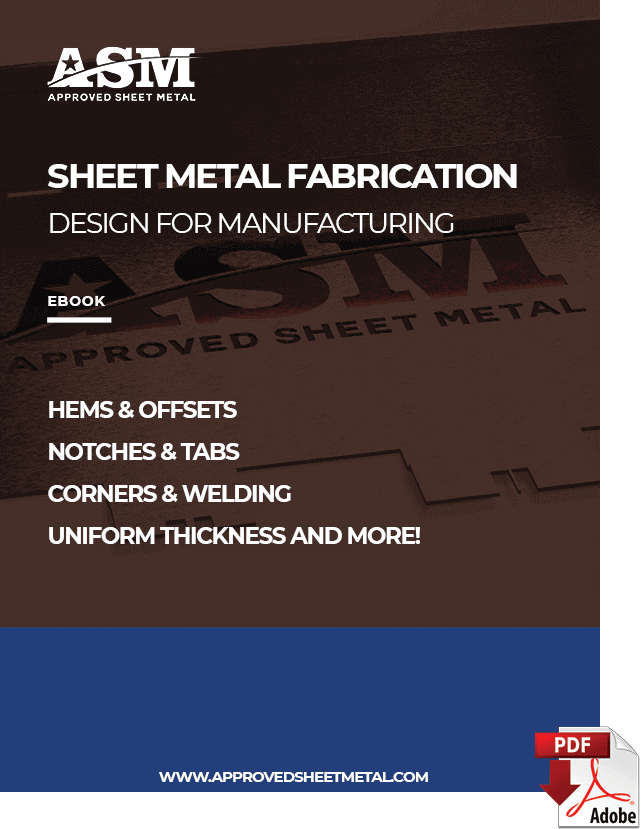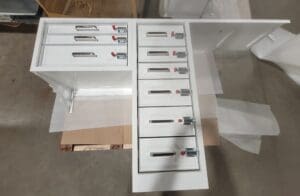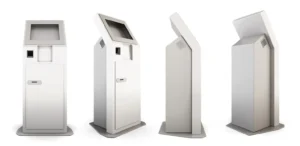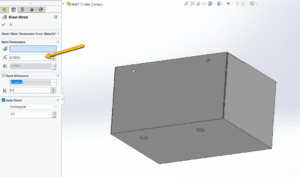Last updated on June 25th, 2024 at 08:39 am
Shorter lead times. Lower costs. A streamlined experience. These are all factors product developers prioritize when they need sheet metal parts.
Here, we explore five best practices to keep in mind when you’re working with Approved Sheet Metal or any other sheet metal shop.
Table of Contents
- 1 1. Send Solid-Body 3D Models
- 2 2. Follow Minimum Bend and Flange Length Guidelines
- 3 3. Communicate Your Exact Requirements—All of Them!
- 4 4. Discuss Material Options
- 5 5. Get Familiar with Sheet Metal Tolerances vs. Machining Tolerances
- 6 Sheet Metal Design for Manufacturing
- 7 Partnering with a Sheet Metal Shop FAQ
- 7.0.1 Why is it essential to send Solid-Body 3D Models for sheet metal fabrication?
- 7.0.2 What issues commonly arise when part designs don't adhere to bend and flange length guidelines in precision metal fabrication?
- 7.0.3 How important is comprehensive communication about part requirements in precision metal fabrication?
- 7.0.4 Why is discussing material options vital in sheet metal fabrication?
- 7.0.5 What's the key difference between sheet metal tolerances and machining tolerances, and why is it important to understand?
1. Send Solid-Body 3D Models
For us to properly unfold and work with your 3D model, it must have a solid body. If your 3D model includes surface imports, it can’t be considered a solid body, and it may be impossible to program the part so it can hit the shop floor.
When our sheet metal shop receives a 3D model with surface imports, there are two possible next steps:
- You can convert your file’s surface import to a solid body model by knitting and thickening the part, then resend your file.
- Our team can add engineering time to your PO and handle the conversion ourselves.
Converting a surface import to a solid body model is often a simple fix. But if your part includes complex geometries, the process can be quite time-consuming. The conversion may also cause certain post-fabrication features to vanish from a model, such as countersinks, machined features, or threaded holes.
You’ll enjoy a smoother precision metal fabrication process if you send us a solid body model from the start.

2. Follow Minimum Bend and Flange Length Guidelines
The most common issues we encounter involve part designs that don’t adhere to our guidelines for bend minimums and flange lengths. These calculations are critical in precision metal fabrication. Fail to follow them, and your part may need additional services, such as machining or custom tooling—or our sheet metal shop may be forced to no-quote the job altogether!
When dealing with improperly calculated flange lengths, we may need to extend the feature and then machine it to the desired length after forming, adding cost and lead time to your project. With certain material times and thicknesses, we’ll have no choice but to outsource the part for machining, further impacting your cost and lead time.
3. Communicate Your Exact Requirements—All of Them!
In precision metal fabrication, there is no such thing as too much information! The more details you provide about your part and its application, the better equipped our sheet metal shop will be to quickly and cost-effectively fabricate it.
Comprehensive callouts typically include these details, among many others:
- Material type and size
- Wall thickness
- Bend radii
- Tolerances
- Hole orientation
- Slot orientation
- Bend allowance
- Bend deduction
- Bend reliefs
- Manufacturing process
- Fabrication process
- Finishing process
4. Discuss Material Options
Material selection plays a crucial role in the success of a sheet metal project, and ASM can help you select the best material for your application.
Even two seemingly identical materials can offer dramatically different quality, durability, formability, strength, corrosion resistance, and more. Two such materials are aluminum alloys 6061-T6 and 5052-H32.
As we explain in this 6061-T6 and 5052-H32 comparison video, T6 aluminum is a popular choice among precision metal fabrication customers, but it’s prone to cracking and breaking during the fabrication process. We advise most customers to swap their T6 selection for 5051-H32 aluminum, which is significantly more cooperative during forming and bending.
Our sheet metal shop is here to help you get the best parts possible, so never hesitate to discuss solutions for improving your parts!
5. Get Familiar with Sheet Metal Tolerances vs. Machining Tolerances
If you weren’t aware that sheet metal tolerances are more complicated than machining tolerances, you’re not alone; many engineers don’t learn about these differences in school.
The sheet metal fabrication process generally yields looser tolerances. Important factors to consider are material thickness and bend radius. Sometimes, achieving tight tolerances with forming alone is impossible, meaning additional processes will be required.
From the start, inform our sheet metal shop of your part’s tolerance requirements, and we’ll ensure you receive an accurate quote that reflects all the steps necessary to get you what you need.
Ready to get started? Request a quote today.
Need more design tips? Check out our Top 6 Custom Sheet Metal Design Blog Posts of 2022
Partnering with a Sheet Metal Shop FAQ
Solid body 3D models are crucial for proper unfolding and programming. Surface imports in 3D models can hinder the process, potentially requiring conversions that might erase specific post-fabrication features, causing delays and additional costs.
Failure to follow minimum bend and flange length guidelines often necessitates additional services like machining or custom tooling. Improperly calculated lengths may force outsourcing for machining, impacting both cost and lead time.
Providing detailed information about materials, tolerances, orientations, manufacturing, fabrication, and finishing processes is crucial. The more specific your requirements, the more efficiently and cost-effectively our sheet metal shop can fabricate your part.
Material selection significantly impacts a project's success. For instance, 5052-H32 aluminum, compared to 6061-T6, offers greater cooperation during forming and bending, reducing the risk of cracking and breaking. Engaging with the fabricator for material suggestions can enhance part quality.
Sheet metal tolerances tend to be looser than machining tolerances due to factors like material thickness and bend radius. Understanding these differences helps in accurately quoting and planning additional processes if tight tolerances are required.





